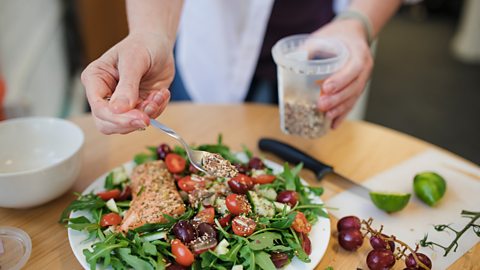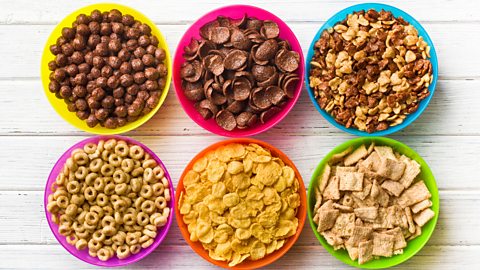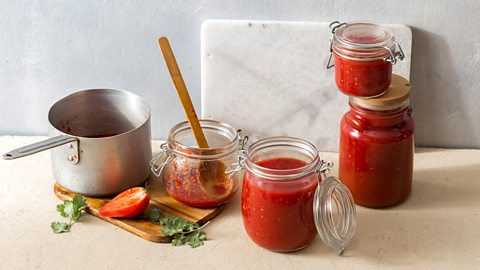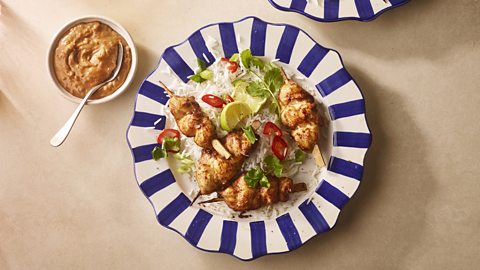How to make the ultimate Diwali sweet box
Diwali will be celebrated on 12 November 2023 and see people all over the world gifting sweet boxes to their loved ones. Here’s how to make your own Diwali sweets at home.
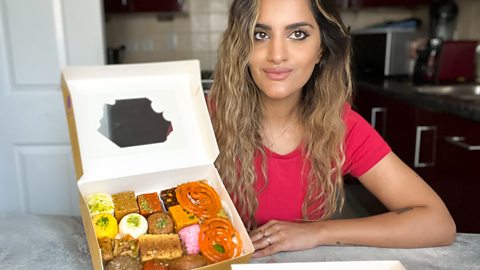
Marked by Hindus, Sikhs, Jains and some Buddhists in India and around the world, Diwali is also known as the Festival of Lights. It lasts for five days, with the main celebrations this year happening on 12 November. During this time, many mithai (sweet) boxes are gifted between loved ones as a way to demonstrate how much they care for one another.
I remember tearing away gift wrap from these Diwali gifts as a child, amazed by the colours, flavours and aromas I found inside.
Mithai boxes have an extra special meaning for me. My grandfather was a confectioner of Indian sweets and private chef specialising in the most fabulous treats. He taught my mother everything he knew about the art of making sweets, and I would watch as she prepared trays upon trays of glimmering bites for the local temple. I’d sample them all, enjoying every mouthful.
Mithai boxes are not just shared on religious and cultural holidays. They’re given on all kinds of happy occasions, like after the birth of a baby, at engagement parties, weddings, graduations and even after a cricket victory! You could say sweets are our love language.
You can buy mithai boxes from Indian sweet shops – there are loads around the UK. Just choose your box size and ask for it to be filled with the sweets you like the look of – it’s like a pick and mix. The magnificent displays of colourful sweets they have would leave me in awe when I was small.
Now I’m older, I like to make my own sweets. It strengthens the bond I have with my family and friends and, as a British Indian, reinforces my relationship with my ancestral culture.
What’s inside a mithai box?
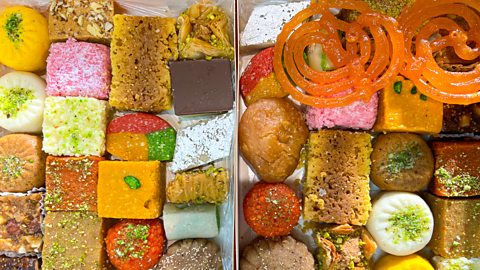 Image source, Sanjana Modha
Image source, Sanjana ModhaHave you ever opened a sweet box and felt the immediate urge to take a bite of everything all at once? This is a familiar story when it comes to mithai boxes, which can contain all kinds of treats in different colours and flavours.
The most traditional flavours are cardamom, saffron, nutmeg, mace, rose, pistachio and almond. But many modern influences are creeping into Diwali sweet boxes now too, meaning you might also spot popular chocolate bars, biscuits and peanut butter. I’ve even seen some modern Indian sweets made with cereal.
Ladoo
The most traditional of all sweets, these were originally served at temples for their convenience and affordability. The little round balls can be fudgy, crumbly or grainy in texture, and can be made from a variety of flours, nuts and seeds. There are so many options and styles (think of how many varieties of cookies there are), but most see the main ingredients cooked with sugar and ghee and then rolled into balls.
For a really simple option, go for an easy coconut ladoo. In a microwave-safe bowl, combine 90g unsweetened desiccated coconut with 90g ground almonds, 125g skimmed milk powder, 250g sweetened condensed milk and ½ tsp ground cardamom. Stir well and warm the ingredients in the microwave for 2–3 minutes before stirring again to form a thick mixture. Allow to cool slightly before rolling into 18 balls.
You can jazz these up by adding different food colourings before you ball the mixture up, or by rolling them in the likes of sprinkles, cocoa or instant espresso powder. This will not only look appealing but help to balance sweetness.
Coconut rose ladoo
Coconut and rose petal jam (or a few drops of rose extract) give these ladoo their flavour
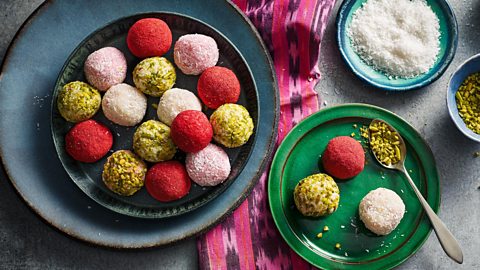
There are a few particularly popular types of ladoo. First, boondi ladoo, which is made by pouring fermented gram flour batter through a perforated spoon. The batter drips through the holes directly into hot oil, forming small pearl-like balls which are then soaked in sugar syrup, flavoured with cardamom, and mixed with ghee and nuts. Motichoor ladoo is similar, but the gram flour balls are much smaller, giving the sweet a slightly different texture. Besan ladoo, meanwhile, is made from roasted gram flour combined with sugar syrup, which is shaped into balls and typically flavoured with cardamom or nutmeg.
Barfi
These melt-in-the-mouth squares of milk fudge are adored for their versatility and for how easy they are to make. Indian sweet shops often have a host of colours and flavours to choose from, since they’re so simple to customise. Most barfi is made from a combination of milk powder, ghee and sugar syrup, but some recipes call for reduced milk solids, condensed milk, or even paneer (a type of Indian cheese).
Some barfi is crowned with edible silver or gold leaf called varkh. This luxurious touch can make them expensive to make and buy, but a similar look can be achieved at home by coating them with edible glitter, sprinkles, dragées or edible metallic shimmer spray used for cake decoration. Some popular types of barfi include milk, besan (made with gram flour) and pistachio.
Barfi
Peanut, ginger and chocolate feature in these moreish little treats
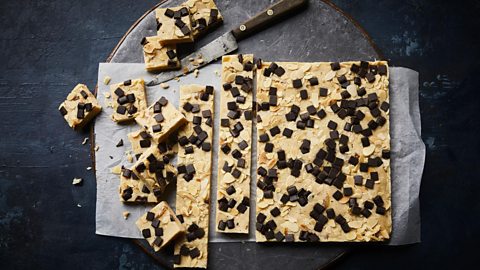
Milk barfi is probably the most straightforward to make at home. Combine 300g full-fat milk powder, 150ml whole milk, 120g sugar, 65g butter and ½ tsp ground cardamom in a non-stick pan. Cook the mixture over a very low heat, stirring all the time for about 10 minutes, until the mixture thickens and resembles mashed potato. Press it into a greased and lined 15cm/6in cake tin and allow to set at room temperature until cool, before cutting into 12 squares.
Halwa
This dish has travelled the breadth of Asia, all the way through to Africa and the Mediterranean. There are lots of different types of halwa (halva), from the sesame halwa of the Middle East to the starch-based halwa popular in Somalia, Kenya, Oman, Pakistan, India and beyond. Different kinds vary considerably – some are set and cut into pieces while others are served soft in a bowl, for instance – but they’re all sweet and usually made from some sort of nut or seed.
Bombay halwa (which is firm and formed into cubes) is the most popular style at Diwali, since it’s beautifully bright in colour with a glassy, translucent finish – just like Turkish delight. Bombay halwa also lasts a long time, so can be bought and stored until you’re ready to gift.
In the same way you’d go to a patisserie for some dishes rather than make them yourself, halwa is probably worth buying rather than making as it takes a lot of practice. I’m not exaggerating when I say I’ve spent years perfecting my recipe!
Halwa
If you’re keen to make halwa, this simplified recipe is a great one to start with
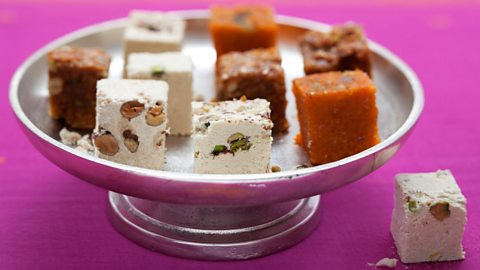
Jamun
Named after the Indian black plum, a jamun is a spherical or oblong-shaped sweet you might compare to a doughnut. Most are made from a dough enriched with milk solids, which caramelises on the outside while the inside stays spongy. After a quick bathe in sugar syrup, jamuns for mithai boxes are rolled in coconut and placed inside a paper case.
Some popular types of jamun include gulab jamun, which is very soft and spongy with a brown exterior, and kala jamun, which has a firmer texture and black exterior.
How to make gulab jamun
Some styles of jamun require a lot of skill to make, but these gulab jamun are a little easier
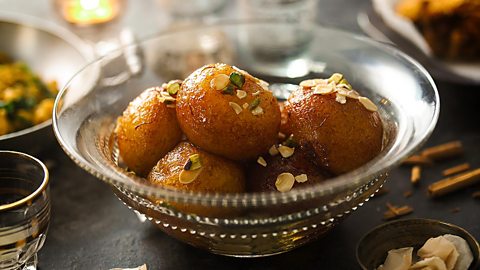
Khaja
This is an umbrella term for pastry-based sweets like ghugra, sata and balushai. Many Indian sweets are made with short pastry or puff pastry that calls for ghee instead of butter. Some are made in a similar way to baklava, while others are fried and glazed with syrup.
Ghugra are very popular at Diwali in my Gujarati culture. They’re little shortcrust pastries filled with a mixture of toasted semolina, ground nuts, sugar and spices and shaped into half-moons (like an empanada or curry puff) then deep fried until the outside is golden brown. Finally, a sugar syrup is ladled over the top, which sets hard to create a crispy shell.
Make a cheat’s version at home using shop-bought shortcrust pastry and icing sugar instead of syrup. To make 12, place a non-stick pan over a medium-low heat and dry roast 30g coarse semolina, 30g unsweetened desiccated coconut and 15g ground almonds until it’s all lightly toasted and a shade darker in colour. Keep stirring all the time so nothing catches and burns. Stir in 1 tbsp butter and 2 tbsp milk, then allow to cool completely. Add 25g granulated sugar, 2 tbsp golden raisins and ½ tsp ground cardamom and stir well to combine. The mixture should resemble coarse sand and come together under firm pressure.
Next, preheat the oven to 200C/180C Fan/Gas 6 and unroll 2 x 320g sheets of cold, readymade shortcrust pastry. Cut out 9cm/3½in circles from the pastry and place a tablespoon of the filling on one side before folding the other half of the disc over to create a half-moon shape. Seal the edges well by crimping with a fork (or pleating, if you know how), arrange on a lined baking tray and brush with milk. Bake for 15–18 minutes, until golden brown all over. Dust with icing sugar and serve.
Celebrate Diwali with Modha’s buttery, cardamom-scented pistachio and rose shortbreads
How to present your sweets
Now you’ve made your sweets, it’s important to think about how to package them up for gifting. Grab an old chocolate box or biscuit tin and cover it in gold or silver wrapping paper, then add a few pieces of colourful tissue before lining with greaseproof paper. If your sweets are bitesize, place them in mini foil or cupcake cases before arranging inside the box.
It’s traditional to include a little tea light in your box. Diyas are small Indian oil lamps that are used to decorate homes and temples during Diwali, symbolising light overcoming darkness. Nowadays, we use tea lights or decorate battery-powered tea lights instead.
And that’s it – after tying a ribbon around your box to seal it, you’re ready to gift it with wishes of love, light and ladoo for the festive season!
Originally published November 2023
